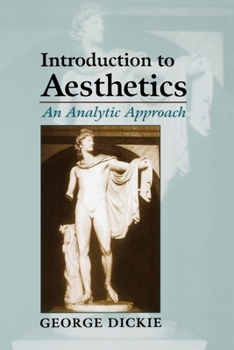Introduction to Aesthetics: An Analytic Approach
Select Format
Select Condition 
Book Overview
This unique and engaging text traces aesthetics from its ancient beginnings through the changes it underwent in the eighteenth, nineteenth, and the first half of the twentieth century. The first part of the book traces the history of the two organized notions of aesthetics-the theory of beauty and the imitation theory of art-and describes the transformations they went through from ancient Greek times until the 1950s. The responses of the cultural theories in the 1960s to these earlier developments are then discussed in detail. Four additional topics-intentionalistic criticism, symbolism, metaphor, and expression-are also addressed. Finally, five traditional art evaluational theories are presented, and the author constructs an evaluational theory of his own by building on ideas drawn from the work of Monroe Beardsley and Nelson Goodman.
Written by one of the foremost philosophers of aesthetics, Introduction to Aesthetics is ideal for undergraduate courses in the philosophy of art and aesthetics, and is also suitable for graduate seminars and courses in these areas. It offers students both a historical introduction to and the latest work on theories of art, theories of the experience of art, and theories of art evaluation.
Written by one of the foremost philosophers of aesthetics, Introduction to Aesthetics is ideal for undergraduate courses in the philosophy of art and aesthetics, and is also suitable for graduate seminars and courses in these areas. It offers students both a historical introduction to and the latest work on theories of art, theories of the experience of art, and theories of art evaluation.
Format:Paperback
Language:English
ISBN:0195113047
ISBN13:9780195113044
Release Date:January 1997
Publisher:Oxford University Press
Length:208 Pages
Weight:0.70 lbs.
Dimensions:0.4" x 6.1" x 9.2"
Customer Reviews
2 ratings
Dickie argues that the audience makes the art
Published by Thriftbooks.com User , 16 years ago
I read this book for a graduate seminar on the philosophy of art. In George Dickie's book "Introduction to Aesthetics," talked about the exhibited qualities of the artwork and non-exhibited which is very helpful because it will show that the traditional theories of art focuses on what the work is expressing, and how does the audience respond to that work of art? If we want to know what art is we have to tie in all four features of art; artist, audience, and institutional artworld to define art. There is a strong presumption that all art is to be presented to an audience no matter the size, this goes to the idea that an artist uses art for communication. Dickie explores what structural role does the audience play in the idea of what is art. Dickie makes a strong assumption, which I agree with, that all art works are meant to be presented to an audience. Audience size does not matter; the artist can be the audience. This goes to the communication idea. Response of audience is a key factor here. How does the audience respond to the work? A deeper question is what historical role does the audience play in the philosophical question of trying to understand, what is art. Art is an intentional object. In some forms of philosophy, the idea of intentionality is to consider the structure of consciousness of something. It is not just consciousness, it is not just the thing, but it is a structure that is related. This is where we get into the question of how essential was the audience's perception to the meaning of art. This is one of the ways in which we can distinguish between an artwork and a natural object. This potential experience is essential to the artwork. If we just talk about an artwork as just a physical object, but that gets us nowhere in trying to understand what makes it an artwork. Therefore, this idea of intentionality and the structure of consciousness is going in that direction. You could use a sculpture as a doorstop, but that is not seeing it as an artwork. Therefore, Dickie observes that the response of an audience becomes the key factor here. This brings up some interesting questions as well. What ought the response of the audience be? Is there something in the artist conception that needs to be communicated, and if the audience doesn't pick it up does that mean the audience failed to respond properly to the art? Or, is it much more fluid? These are just some of the questions Dickie ponders. I recommend this work for anyone interested in philosophy, philosophy of art.
Hard-to Understand Subject Matter-Easy to Understand Book
Published by Thriftbooks.com User , 25 years ago
A comprehensive and understandable look at aesthetics. I've read some of the philosophies that Dickie covers in this book and understood his summery of them much better than the work by the philosophers themselves. A definite good buy for anyone who is in art education or anyone else who wants to understand aesthetics. Overall, a good approach at a rather confusing subject.






